Global Platinum Market Forecast
- Platinum market size likely to jump from US$6.9 Bn in 2022 to US$9.9 Bn in 2030
- Global market valuation set for a healthy rise at CAGR of 5.3% during 2023 - 2030
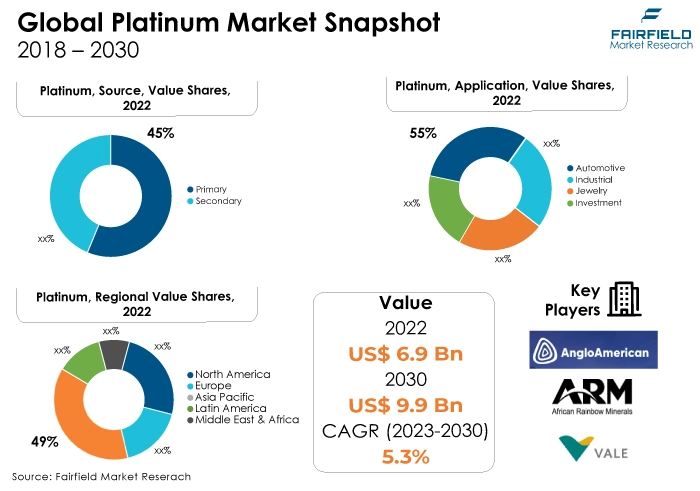
Major Report Findings - Fairfield's Perspective
- The key trend anticipated to drive the platinum market growth is an increasing demand for emission reduction regulations. Furthermore, nitrogen oxide (NOx), carbon monoxide (CO), and hydrocarbons (HC) emissions by using metals like palladium and rhodium. Platinum is increasingly in demand for use in catalytic converters as emissions regulations tighten.
- Another major market trend expected to drive the platinum market growth is the rapidly expanding supply chain concerns. Governments or industry participants may strategically hoard platinum as a buffer against potential disruptions as a result of worries about future supply restrictions. Attempts to stockpile goods may increase demand and market growth.
- Environmental restrictions may increase the need for platinum in catalytic converters. Still, they may also create challenges if automakers switch to electric vehicles or if governments alter their pollution regulations, which would reduce the market for conventional catalytic converters.
- In 2022, the primary category dominated the industry. The majority of the world's platinum is produced in South Africa. A significant portion of the world's platinum production comes from the vast platinum resources found in South Africa's Bushveld Igneous Complex.
- In 2022, the automotive category dominated the industry. Diesel engines, which are frequently found in commercial vehicles and some passenger cars, are a major source of emissions; platinum-based catalysts are particularly crucial in decreasing these emissions. In diesel automobiles, platinum helps reduce NOx emissions.
- The industrial segment is anticipated to increase at the fastest rate of the platinum market during the forecast period. Chemical sensors made from platinum are used in industrial monitoring and control systems to detect gases, humidity, and other environmental factors.
- Asia Pacific is expected to dominate the platinum market during the forecast period. The Asia Pacific region is making significant investments in hydrogen technologies and renewable energy sources. Platinum supports the sustainability goals of the area by being used in green energy applications like hydrogen fuel cells and electrolyzers.
- Europe is expected to be the fastest-growing platinum market region. Platinum jewellery has a robust market in Europe, especially in nations like the UK, and Italy. Due to its strength and aesthetic appeal, platinum is frequently chosen, which boosts demand in the luxury goods market.
Current, Historical, and Futuristic Analysis
Emerging economies usually experience rapid expansion in their automobile sectors as wages rise and urbanisation continues. The demand for automobiles, particularly those with platinum-based catalytic converters, is heavily influenced by these markets. As more people in emerging markets own vehicles, there is a growing need for platinum in the automotive industry. The demand for platinum in many industrial applications is rising as emerging nations industrialise. Electronics, energy production, chemical manufacture, and industrial pollution management are just a few industries that employ platinum.
The market witnessed staggered growth during the historical period 2018 - 2022. Investor trust increased as companies engaged in platinum production and pollution control technology proved their adherence to emission standards and made a positive impact on the environment. Industrial boilers were equipped with platinum-based catalysts to lower NOx emissions, resulting in better air quality and adherence to environmental laws. Control of diesel engine emissions, which was frequently utilised in commercial applications, was given a lot of attention. To successfully minimise NOx emissions, diesel vehicles' catalytic converters have to include substantial amounts of platinum.
A prominent use for platinum is in emissions control in power plants, especially those burning fossil fuels. Sulfur dioxide (SO2), nitrogen oxides (NOx), and other pollutants are reduced by using it in the coming years. Additionally, Catalytic converters and other emissions control devices frequently contain platinum. Recycling outdated automobiles and industrial machinery aids in recovering platinum for subsequent uses, enhancing the platinum market's viability. Furthermore, Hydrogen fuel cells, which are regarded as a clean energy technology, require platinum as a key component. Platinum is necessary to enable the production of emissions-free energy and the expansion of the hydrogen economy during the next five years.
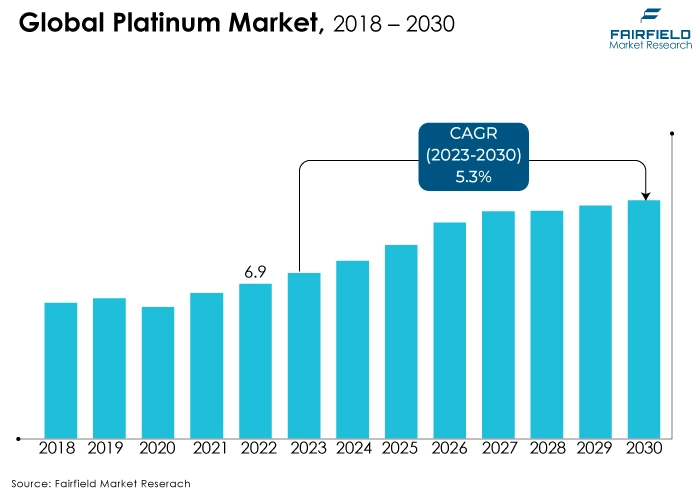
Key Growth Determinants
- Increasing Demand from Automotive Industry
Catalytic converters, which are put in cars to lessen harmful emissions like carbon monoxide (CO), nitrogen oxides (NOx), and hydrocarbons (HC), require platinum as a key component. The need for platinum in these converters has increased because of the regulations setting strict emissions standards.
To battle air pollution and address climate change concerns, governments all over the world have put in place strict emission controls. To comply with these rules, automakers must use more platinum in their catalytic converters, which increases demand for the metal.
The global automotive market is still growing, particularly in developing nations like China, and India. Due to the requirement for a platinum-containing catalytic converter in every new vehicle, increased automotive production raises the demand for platinum.
- Rising Buzz Around Platinum Jewellery
One of the most valuable and prestigious metals used in jewellery is platinum, which is prized for its brilliance, toughness, and rarity. Platinum is in higher demand because of consumers' preference for high-end, luxurious jewellery.
Due to its symbolic significance, aesthetic appeal, and durability, platinum is a preferred metal for wedding and engagement rings. The custom of exchanging platinum wedding rings helps to sustain the high demand for platinum in the bridal jewellery market.
The market for platinum jewellery has expanded in emerging nations with a growing middle class such as India, and China. The demand for upscale products like platinum jewellery increases as these markets expand.
- Broadening Industrial Application
Platinum is used as a catalyst in a variety of chemical processes, including the production of chemicals, the refinement of petroleum, and the synthesis of polymers and fertilizers. Due to its catalytic properties, which raise reaction rates and efficiency, the chemical industry is driven by demand.
In the petroleum sector, platinum is utilised in catalytic reforming procedures to create high-octane petrol and other refined products. Platinum is increasingly needed for refining processes as the world's demand for energy rises.
In the creation of hydrogen, techniques like steam methane reforming (SMR) and water electrolysis, platinum is essential. These procedures are necessary for the manufacture of hydrogen fuel, a burgeoning industry supported by clean transportation and renewable energy.
Major Growth Barriers
- Notable Price Volatility
Platinum may be a riskier investment due to its high price volatility, which discourages some investors. In the market, the number of buyers and sellers may be constrained if investors seeking stability turn their attention elsewhere.
Businesses that depend on platinum, like the automotive and jewellery industries, may be reluctant to make significant purchases or sign long-term contracts while prices are so volatile. Production disruptions and difficulties with the supply chain may result from this uncertainty.
When prices are unstable, platinum mining businesses may need help organising and carrying out their activities. This may impact their capacity to fund new endeavors and increase output.
- Availability of Substitute Metals
Palladium and rhodium are two metals that are frequently substituted for platinum in catalytic converters, especially in gasoline-powered vehicles. If manufacturers opt to use these other metals when prices are more advantageous, the demand for platinum in the automotive sector may decrease.
Palladium, and rhodium, the two alternative metals, may lead to price rivalry in the catalytic converter market as they are utilised more frequently. Platinum prices may be under pressure from this competition, and its market share in pollution control systems may be constrained.
Key Trends and Opportunities to Look at
- Expanding Green Energy Sector
Platinum is an essential component of proton exchange membrane fuel cells (PEMFCs), which are used to produce renewable energy. The demand for platinum in fuel cell catalysts rises as the green energy industry develops, particularly in hydrogen fuel cell technology.
Platinum-dependent innovations may result from increased investment in research and development related to green energy. Improvements in the effectiveness of fuel cells and the creation of novel catalyst materials are included in this.
Platinum's significance in enabling clean energy technology is anticipated to grow as governments and industries throughout the world move towards more environmentally friendly and sustainable energy sources.
- Growing Technological Advancements
Modern battery technologies, such as redox flow batteries, which are essential for energy storage in renewable energy systems, contain platinum. Platinum's importance in energy storage may rise because of the advancements in battery technology and composition.
Alternative catalyst materials and nanostructured catalysts that consume less platinum while maintaining high activity are being researched by scientists. These advancements may result in catalytic converters that are more effective and use less platinum.
Platinum is a crucial component in electrolyzers that produce hydrogen. Platinum demand may rise as a result of improvements in electrolyzer technology that make green hydrogen more scaleable and economical.
- Rising Sustainable Mining and Ethical Sourcing
Conscious consumers are willing to pay more for products that are supplied ethically and sustainably, and ethical and sustainable mining techniques appeal to them. Jewellery and other platinum products with verifiable moral origins might be more in demand.
Companies that practice ethical sourcing and sustainability frequently have strong brand reputations, which can lead to greater platinum market sales and consumer loyalty.
By lowering operational risks associated with environmental and social considerations, sustainable mining techniques help ensure the long-term viability of platinum mining operations.
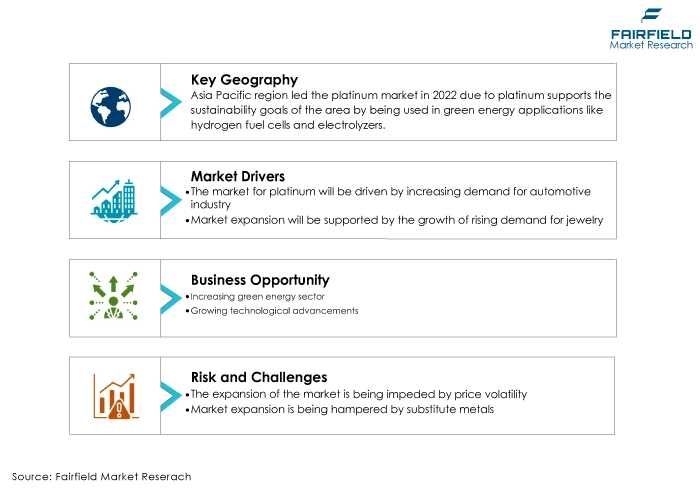
How Does the Regulatory Scenario Shape this Industry?
Over the last three years, the production, trade, and use of platinum are all subject to a variety of regulatory frameworks and organisations. Vehicle emissions laws are enforced by the Environmental Protection Agency (EPA), and these standards include specifications for platinum-based catalytic converters.
In the car industry, stricter emissions regulations may result in higher platinum demand. The European Union Emissions Trading System (EU ETS) includes rules for car emissions and establishes emission reduction targets for member nations. Demand for platinum in catalytic converters may increase because of compliance with these requirements.
The international trade of platinum may be impacted by trade agreements and conflicts among nations that produce and use platinum. Tariffs, trade limitations, and export/import regulations may have an impact on the cost and accessibility of platinum.
The Responsible Jewellery Council (RJC) establishes guidelines for the responsible and ethical sourcing of platinum and other precious metals in the jewellery sector. RJC standards compliance can improve the marketability of platinum products.
The mining operations, including the extraction of platinum, are regulated by this South African government organisation. The availability and production of platinum can be affected by laws governing mining safety, environmental impact studies, and resource allocation.
Fairfield’s Ranking Board
Top Segments
- Primary Platinum Dominant over Secondary Counterpart
The primary segment dominated the market in 2022. This includes platinum obtained by mining. Most of the market's supply of primary platinum is produced, which is primarily supported by large-scale mining activities in nations like South Africa, Russia, and Zimbabwe.
South Africa had nearly 137 tons of commodities, followed by Russia (22 tons), and Zimbabwe (15 tons) in 2018. Due to their substantial platinum reserves and established mining infrastructure, these areas are able to hold onto a significant share of the market.
Furthermore, the secondary category is projected to experience the fastest market growth. This involves recovering and recycling platinum. Recycled platinum is becoming more and more in demand from a variety of industries as sustainability, and resource conservation become more and more important.
Innovations in recycling technologies and programmes supporting the circular economy are what are driving the secondary segment. By decreasing the dependency on primary mining and lowering the environmental impact connected to the extraction and refining processes, it provides economic and ecological benefits. Because of this, the secondary segment is expanding quickly and taking center stage in the global platinum market.
- Automotive Industry
The automotive segment dominated the market in 2022. Due to the increased usage of commodities in the production of car catalytic converters. Automotive vendors have been under increasing pressure from regulatory agencies to improve their fuel efficiency while lowering overall pollution emissions.
The domination of this market is mostly due to the substantial demand for platinum from the automotive industry, particularly in nations with high levels of automobile production like Europe, China, and North America.
During the forecasted period, the industrial category is expected to expand substantially. Investors are paying more attention as platinum prices continue to decline.
Investors are mostly concentrating on purchasing platinum bars and bullion due to the low pricing. Investments associated with bars will probably continue to be a significant portion of the category mentioned above over the anticipated time frame.
Regional Frontrunners
Asia Pacific Tops on Account of Exploding Auto Markets
During the projected period, Asia Pacific is anticipated to dominate the platinum market. Due to the presence of nations with strong auto industries, such as India, China, and Japan.
Additionally, it is possible that the installation of new regulatory standards, like BS-VI in the Indian car industry, will encourage manufacturers to cut back on pollutant emissions and improve fuel efficiency.
Strong investor demand for the product is another important factor in fostering regional growth. According to a World Gold Council survey, the Chinese "Gen-Z" prefers diamond and platinum jewellery over gold jewellery items.
A significant fraction of the population will belong to this category in the upcoming years. As a result, the market that was examined will experience an increase in demand for platinum jewellery.
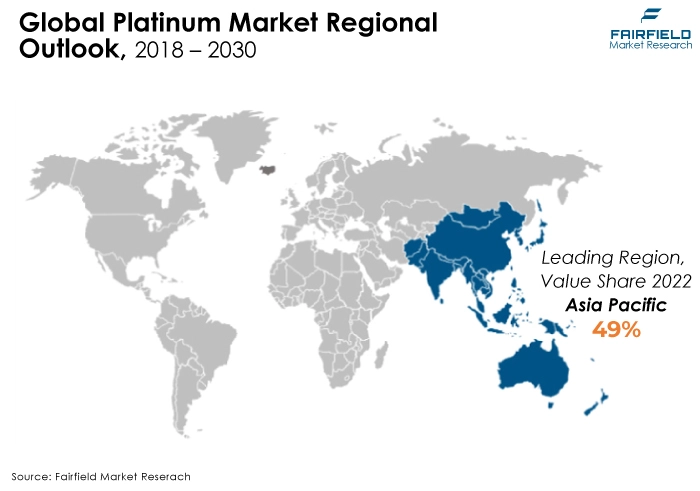
Europe Likely to Witness the Significant Growth in Sales During Forecast Period
The platinum market is anticipated to expand fastest in Europe. Due to geopolitical and Brexit-related uncertainty, the region saw stagnant demand between 2019 and 2021. It did, however, observe a good trend in 2021 due to the rising demand for diesel hybrid automobiles.
The European Automobile Manufacturers Association (ACEA) presented data showing a 47.0% rise in hybrid car production in 2019. Europe is making significant investments in hydrogen as a source of sustainable energy.
In hydrogen fuel cells, a vital component of the hydrogen economy, platinum plays a crucial role. Platinum demand in this industry is anticipated to increase as Europe embraces hydrogen-based technology.
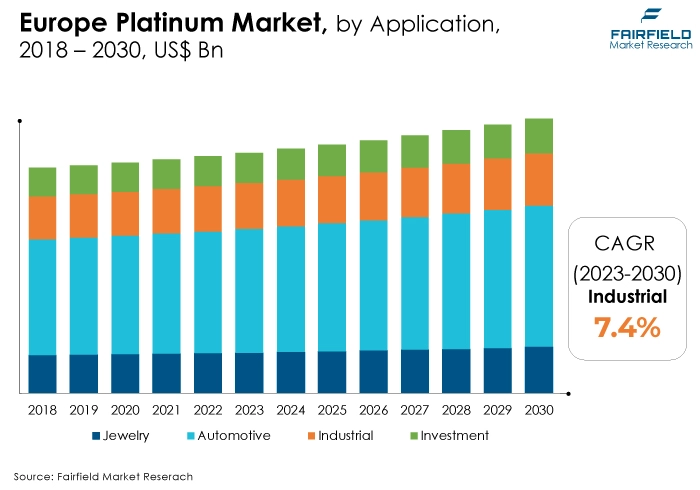
Fairfield’s Competitive Landscape Analysis
The highly competitive market for platinum is home to many well-known businesses. Large companies are expanding their distribution networks, introducing revolutionary products, and releasing new products to increase their market share globally. Moreover, Fairfield Market Research is expecting the market to witness more consolidation over the coming years.
Who are the Leaders in the Global Platinum Space?
- Vale SA
- Asahi Holdings, Inc.,
- African Rainbow Minerals
- Eastern Platinum
- Eurasia Mining PLC
- Anglo American Platinum Ltd.
- Implants Platinum Ltd.
- Sibanye-Stillwater
- Norilsk Nickel
- Northam Platinum Ltd.
- Chimet Spa
- Heesung Pmtech
- Heraeus Holding
- Hindustan Platinum
- Impala Platinum Holdings Limited
Key Company Developments
New Product Launches
- September 2023: New sustainable platinum mining operations have begun in South Africa, according to Anglo American Platinum. Over a 30-year mine life, the new project, known as Mogalakwena North, is anticipated to yield about 200,000 ounces of platinum annually.
- July 2023: A brand-new platinum-based catalyst for fuel cells was launched by Johnson Matthey. The cost of fuel cells is anticipated to decrease because of the new motivation, which is more effective and long-lasting than prior catalysts.
- June 2023: A brand-new platinum-based catalyst for hydrogen synthesis was introduced by BASF. The cost of producing hydrogen is anticipated to decrease due to the new motivation, which is more effective and long-lasting than prior catalysts.
Distribution Agreements
- October 2022: Asahi Holdings and Anglo American Platinum have a distribution agreement. Asahi Holdings will be able to market platinum products made by Anglo American Platinum in Japan according to the arrangement.
- December 2022: A distribution contract was settled by Johnson Matthey and the Shanghai Gold Exchange (SGE). Johnson Matthey will be able to sell its platinum goods on the SGE, the biggest physical gold market in the world, due to the arrangement.
An Expert’s Eye
Demand and Future Growth
As per Fairfield’s Analysis, redox flow batteries are a kind of energy storage device that utilises platinum-based catalysts. These batteries use soluble redox couples to store electrical energy, and platinum is essential to the battery's effectiveness.
Platinum's application in redox flow batteries is anticipated to rise as the need for large-scale energy storage solutions grows to counteract the erratic nature of renewable energy sources like wind and solar.
Furthermore, like gold, and silver, platinum is frequently seen as a safe-haven asset. Investors may use precious metals, including platinum, as a store of value under uncertain economic, geopolitical, or market conditions.
Prices for platinum may rise as demand for safe-haven assets increases. However, the platinum market is expected to face considerable challenges because of price volatility.
Supply Side of the Market
South Africa will be the largest producer of platinum in the world in 2022, accounting for about 70% of global production. Most of the country's platinum reserves are found in the Bushveld Complex, a geological formation that houses some of the largest and most productive platinum mines in the world.
Some of the major platinum mining companies in South Africa include Impala Platinum, Sibanye Stillwater, and Anglo-American Platinum. In 2022, almost 10% of the world's platinum will be produced in Russia, which is the second-largest producer in the world. The Norilsk-Talnakh region, which is also home to some of the biggest and most productive nickel mines in the world, is where the nation's platinum resources are found.
Russian mining giants Norilsk Nickel, and MMC Norilsk Nickel are among the biggest producers of platinum. South Africa produced nearly 137 tons of commodities, and Russia (22 tons) in 2018. The United States will utilise more platinum than any other nation in North America in 2022, accounting for a market share of more than 50%.
Higher use of platinum in the United States is due to several factors, including the huge automobile industry, the thriving jewellery business, and the increasing demand for platinum in the industrial sector. Additional significant users of platinum in North America are Canada, and Mexico.
The Global Platinum Market is Segmented as Below:
By Source:
- Primary
- Secondary
By Application:
- Automotive
- Jewellery
- Industrial
- Investment
By Geographic Coverage:
- North America
- U.S.
- Canada
- Europe
- Germany
- U.K.
- France
- Italy
- Turkey
- Russia
- Rest of Europe
- Asia Pacific
- China
- Japan
- South Korea
- India
- Southeast Asia
- Rest of Asia Pacific
- Latin America
- Brazil
- Mexico
- Argentina
- Rest of Latin America
- Middle East & Africa
- GCC
- South Africa
- Egypt
- Nigeria
- Rest of Middle East & Africa
1. Executive Summary
1.1. Global Platinum Market Snapshot
1.2. Future Projections
1.3. Key Market Trends
1.4. Regional Snapshot, by Value, 2022
1.5. Analyst Recommendations
2. Market Overview
2.1. Market Definitions and Segmentations
2.2. Market Dynamics
2.2.1. Drivers
2.2.2. Restraints
2.2.3. Market Opportunities
2.3. Value Chain Analysis
2.4. Porter’s Five Forces Analysis
2.5. COVID-19 Impact Analysis
2.5.1. Supply
2.5.2. Demand
2.6. Impact of Ukraine-Russia Conflict
2.7. Economic Overview
2.7.1. World Economic Projections
2.8. PESTLE Analysis
3. Global Platinum Market Outlook, 2018 - 2030
3.1. Global Platinum Market Outlook, by Source, Value (US$ Bn), 2018 - 2030
3.1.1. Key Highlights
3.1.1.1. Primary
3.1.1.2. Secondary
3.2. Global Platinum Market Outlook, by Application, Value (US$ Bn), 2018 - 2030
3.2.1. Key Highlights
3.2.1.1. Automotive
3.2.1.2. Jewellery
3.2.1.3. Industrial
3.2.1.4. Investment
3.3. Global Platinum Market Outlook, by Region, Value (US$ Bn), 2018 - 2030
3.3.1. Key Highlights
3.3.1.1. North America
3.3.1.2. Europe
3.3.1.3. Asia Pacific
3.3.1.4. Latin America
3.3.1.5. Middle East & Africa
4. North America Platinum Market Outlook, 2018 - 2030
4.1. North America Platinum Market Outlook, by Source, Value (US$ Bn), 2018 - 2030
4.1.1. Key Highlights
4.1.1.1. Primary
4.1.1.2. Secondary
4.2. North America Platinum Market Outlook, by Application, Value (US$ Bn), 2018 - 2030
4.2.1. Key Highlights
4.2.1.1. Automotive
4.2.1.2. Jewellery
4.2.1.3. Industrial
4.2.1.4. Investment
4.2.2. BPS Analysis/Market Attractiveness Analysis
4.3. North America Platinum Market Outlook, by Country, Value (US$ Bn), 2018 - 2030
4.3.1. Key Highlights
4.3.1.1. U.S. Platinum Market by Source, Value (US$ Bn), 2018 - 2030
4.3.1.2. U.S. Platinum Market Application, Value (US$ Bn), 2018 - 2030
4.3.1.3. Canada Platinum Market by Source, Value (US$ Bn), 2018 - 2030
4.3.1.4. Canada Platinum Market Application, Value (US$ Bn), 2018 - 2030
4.3.2. BPS Analysis/Market Attractiveness Analysis
5. Europe Platinum Market Outlook, 2018 - 2030
5.1. Europe Platinum Market Outlook, by Source, Value (US$ Bn), 2018 - 2030
5.1.1. Key Highlights
5.1.1.1. Primary
5.1.1.2. Secondary
5.2. Europe Platinum Market Outlook, by Application, Value (US$ Bn), 2018 - 2030
5.2.1. Key Highlights
5.2.1.1. Automotive
5.2.1.2. Jewellery
5.2.1.3. Industrial
5.2.1.4. Investment
5.2.2. BPS Analysis/Market Attractiveness Analysis
5.3. Europe Platinum Market Outlook, by Country, Value (US$ Bn), 2018 - 2030
5.3.1. Key Highlights
5.3.1.1. Germany Platinum Market by Source, Value (US$ Bn), 2018 - 2030
5.3.1.2. Germany Platinum Market Application, Value (US$ Bn), 2018 - 2030
5.3.1.3. U.K. Platinum Market by Source, Value (US$ Bn), 2018 - 2030
5.3.1.4. U.K. Platinum Market Application, Value (US$ Bn), 2018 - 2030
5.3.1.5. France Platinum Market by Source, Value (US$ Bn), 2018 - 2030
5.3.1.6. France Platinum Market Application, Value (US$ Bn), 2018 - 2030
5.3.1.7. Italy Platinum Market by Source, Value (US$ Bn), 2018 - 2030
5.3.1.8. Italy Platinum Market Application, Value (US$ Bn), 2018 - 2030
5.3.1.9. Turkey Platinum Market by Source, Value (US$ Bn), 2018 - 2030
5.3.1.10. Turkey Platinum Market Application, Value (US$ Bn), 2018 - 2030
5.3.1.11. Russia Platinum Market by Source, Value (US$ Bn), 2018 - 2030
5.3.1.12. Russia Platinum Market Application, Value (US$ Bn), 2018 - 2030
5.3.1.13. Rest of Europe Platinum Market by Source, Value (US$ Bn), 2018 - 2030
5.3.1.14. Rest of Europe Platinum Market Application, Value (US$ Bn), 2018 - 2030
5.3.2. BPS Analysis/Market Attractiveness Analysis
6. Asia Pacific Platinum Market Outlook, 2018 - 2030
6.1. Asia Pacific Platinum Market Outlook, by Source, Value (US$ Bn), 2018 - 2030
6.1.1. Key Highlights
6.1.1.1. Primary
6.1.1.2. Secondary
6.2. Asia Pacific Platinum Market Outlook, by Application, Value (US$ Bn), 2018 - 2030
6.2.1. Key Highlights
6.2.1.1. Automotive
6.2.1.2. Jewellery
6.2.1.3. Industrial
6.2.1.4. Investment
6.2.2. BPS Analysis/Market Attractiveness Analysis
6.3. Asia Pacific Platinum Market Outlook, by Country, Value (US$ Bn), 2018 - 2030
6.3.1. Key Highlights
6.3.1.1. China Platinum Market by Source, Value (US$ Bn), 2018 - 2030
6.3.1.2. China Platinum Market Application, Value (US$ Bn), 2018 - 2030
6.3.1.3. Japan Platinum Market by Source, Value (US$ Bn), 2018 - 2030
6.3.1.4. Japan Platinum Market Application, Value (US$ Bn), 2018 - 2030
6.3.1.5. South Korea Platinum Market by Source, Value (US$ Bn), 2018 - 2030
6.3.1.6. South Korea Platinum Market Application, Value (US$ Bn), 2018 - 2030
6.3.1.7. India Platinum Market by Source, Value (US$ Bn), 2018 - 2030
6.3.1.8. India Platinum Market Application, Value (US$ Bn), 2018 - 2030
6.3.1.9. Southeast Asia Platinum Market by Source, Value (US$ Bn), 2018 - 2030
6.3.1.10. Southeast Asia Platinum Market Application, Value (US$ Bn), 2018 - 2030
6.3.1.11. Rest of Asia Pacific Platinum Market by Source, Value (US$ Bn), 2018 - 2030
6.3.1.12. Rest of Asia Pacific Platinum Market Application, Value (US$ Bn), 2018 - 2030
6.3.2. BPS Analysis/Market Attractiveness Analysis
7. Latin America Platinum Market Outlook, 2018 - 2030
7.1. Latin America Platinum Market Outlook, by Source, Value (US$ Bn), 2018 - 2030
7.1.1. Key Highlights
7.1.1.1. Primary
7.1.1.2. Secondary
7.2. Latin America Platinum Market Outlook, by Application, Value (US$ Bn), 2018 - 2030
7.2.1. Key Highlights
7.2.1.1. Automotive
7.2.1.2. Jewellery
7.2.1.3. Industrial
7.2.1.4. Investment
7.2.2. BPS Analysis/Market Attractiveness Analysis
7.3. Latin America Platinum Market Outlook, by Country, Value (US$ Bn), 2018 - 2030
7.3.1. Key Highlights
7.3.1.1. Brazil Platinum Market by Source, Value (US$ Bn), 2018 - 2030
7.3.1.2. Brazil Platinum Market Application, Value (US$ Bn), 2018 - 2030
7.3.1.3. Mexico Platinum Market by Source, Value (US$ Bn), 2018 - 2030
7.3.1.4. Mexico Platinum Market Application, Value (US$ Bn), 2018 - 2030
7.3.1.5. Argentina Platinum Market by Source, Value (US$ Bn), 2018 - 2030
7.3.1.6. Argentina Platinum Market Application, Value (US$ Bn), 2018 - 2030
7.3.1.7. Rest of Latin America Platinum Market by Source, Value (US$ Bn), 2018 - 2030
7.3.1.8. Rest of Latin America Platinum Market Application, Value (US$ Bn), 2018 - 2030
7.3.2. BPS Analysis/Market Attractiveness Analysis
8. Middle East & Africa Platinum Market Outlook, 2018 - 2030
8.1. Middle East & Africa Platinum Market Outlook, by Source, Value (US$ Bn), 2018 - 2030
8.1.1. Key Highlights
8.1.1.1. Primary
8.1.1.2. Secondary
8.2. Middle East & Africa Platinum Market Outlook, by Application, Value (US$ Bn), 2018 - 2030
8.2.1. Key Highlights
8.2.1.1. Automotive
8.2.1.2. Jewellery
8.2.1.3. Industrial
8.2.1.4. Investment
8.2.2. BPS Analysis/Market Attractiveness Analysis
8.3. Middle East & Africa Platinum Market Outlook, by Country, Value (US$ Bn), 2018 - 2030
8.3.1. Key Highlights
8.3.1.1. GCC Platinum Market by Source, Value (US$ Bn), 2018 - 2030
8.3.1.2. GCC Platinum Market Application, Value (US$ Bn), 2018 - 2030
8.3.1.3. South Africa Platinum Market by Source, Value (US$ Bn), 2018 - 2030
8.3.1.4. South Africa Platinum Market Application, Value (US$ Bn), 2018 - 2030
8.3.1.5. Egypt Platinum Market by Source, Value (US$ Bn), 2018 - 2030
8.3.1.6. Egypt Platinum Market Application, Value (US$ Bn), 2018 - 2030
8.3.1.7. Nigeria Platinum Market by Source, Value (US$ Bn), 2018 - 2030
8.3.1.8. Nigeria Platinum Market Application, Value (US$ Bn), 2018 - 2030
8.3.1.9. Rest of Middle East & Africa Platinum Market by Source, Value (US$ Bn), 2018 - 2030
8.3.1.10. Rest of Middle East & Africa Platinum Market Application, Value (US$ Bn), 2018 - 2030
8.3.2. BPS Analysis/Market Attractiveness Analysis
9. Competitive Landscape
9.1. Capacity vs Application Heatmap
9.2. Manufacturer vs Application Heatmap
9.3. Company Market Share Analysis, 2022
9.4. Competitive Dashboard
9.5. Company Profiles
9.5.1. Vale SA
9.5.2. Asahi Holdings, Inc.,
9.5.2.1. Company Overview
9.5.2.2. Product Portfolio
9.5.2.3. Financial Overview
9.5.2.4. Business Strategies and Development
9.5.3. African Rainbow Minerals
9.5.3.1. Company Overview
9.5.3.2. Product Portfolio
9.5.3.3. Financial Overview
9.5.3.4. Business Strategies and Development
9.5.4. Eastern Platinum
9.5.4.1. Company Overview
9.5.4.2. Product Portfolio
9.5.4.3. Financial Overview
9.5.4.4. Business Strategies and Development
9.5.5. Eurasia Mining PLC
9.5.5.1. Company Overview
9.5.5.2. Product Portfolio
9.5.5.3. Financial Overview
9.5.5.4. Business Strategies and Development
9.5.6. Anglo American Platinum Ltd.
9.5.6.1. Company Overview
9.5.6.2. Product Portfolio
9.5.6.3. Financial Overview
9.5.6.4. Business Strategies and Development
9.5.7. Implats Platinum Ltd.
9.5.7.1. Company Overview
9.5.7.2. Product Portfolio
9.5.7.3. Financial Overview
9.5.7.4. Business Strategies and Development
9.5.8. Sibanye-Stillwater
9.5.8.1. Company Overview
9.5.8.2. Product Portfolio
9.5.8.3. Financial Overview
9.5.8.4. Business Strategies and Development
9.5.9. Norilsk Nickel
9.5.9.1. Company Overview
9.5.9.2. Product Portfolio
9.5.9.3. Financial Overview
9.5.9.4. Business Strategies and Development
9.5.10. Northam Platinum Ltd.
9.5.10.1. Company Overview
9.5.10.2. Product Portfolio
9.5.10.3. Financial Overview
9.5.10.4. Business Strategies and Development
9.5.11. Chimet Spa
9.5.11.1. Company Overview
9.5.11.2. Product Portfolio
9.5.11.3. Financial Overview
9.5.11.4. Business Strategies and Development
9.5.12. Heesung Pmtech
9.5.12.1. Company Overview
9.5.12.2. Product Portfolio
9.5.12.3. Financial Overview
9.5.12.4. Business Strategies and Development
9.5.13. Heraeus Holding
9.5.13.1. Company Overview
9.5.13.2. Product Portfolio
9.5.13.3. Financial Overview
9.5.13.4. Business Strategies and Development
9.5.14. Hindustan Platinum
9.5.14.1. Company Overview
9.5.14.2. Product Portfolio
9.5.14.3. Financial Overview
9.5.14.4. Business Strategies and Development
9.5.15. Impala Platinum Holdings Limited
9.5.15.1. Company Overview
9.5.15.2. Product Portfolio
9.5.15.3. Financial Overview
9.5.15.4. Business Strategies and Development
10. Appendix
10.1. Research Methodology
10.2. Report Assumptions
10.3. Acronyms and Abbreviations
|
BASE YEAR |
HISTORICAL DATA |
FORECAST PERIOD |
UNITS |
|||
|
2022 |
|
2018 - 2022 |
2023 - 2030 |
Value: US$ Million |
||
|
REPORT FEATURES |
DETAILS |
|
Source Coverage |
|
|
Application Coverage |
|
|
Geographical Coverage |
|
|
Leading Companies |
|
|
Report Highlights |
Key Market Indicators, Macro-micro economic impact analysis, Technological Roadmap, Key Trends, Driver, Restraints, and Future Opportunities & Revenue Pockets, Porter’s 5 Forces Analysis, Historical Trend (2019-2021), Market Estimates and Forecast, Market Dynamics, Industry Trends, Competition Landscape, Category, Region, Country- wise Trends & Analysis, COVID-19 Impact Analysis (Demand and Supply Chain) |
